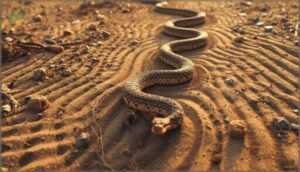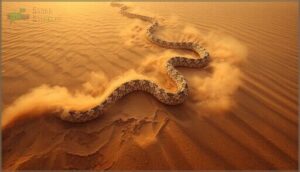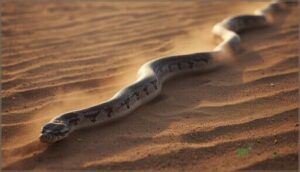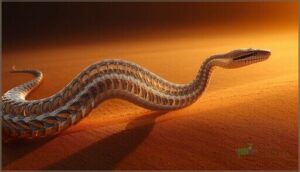This site is supported by our readers. We may earn a commission, at no cost to you, if you purchase through links.
Watch a snake glide across the ground and you’ll witness one of nature’s most elegant paradoxes—seamless speed without a single limb. No legs, no arms, no fins. Just pure muscle and physics working in perfect harmony.
While most animals rely on appendages to push against their environment, snakes turned losing their legs into an evolutionary jackpot. Their bodies became living waves, capable of conquering deserts, trees, water, and everything in between.
The secret lies in four distinct locomotion modes—lateral undulation, concertina movement, sidewinding, and rectilinear crawling—each powered by hundreds of vertebrae, coordinated muscle contractions, and specialized belly scales that grip like microscopic cleats.
Table Of Contents
- Key Takeaways
- How Do Snakes Move?
- Main Types of Snake Locomotion
- Anatomy Behind Snake Movement
- Environmental Influences on Snake Movement
- Evolution and Adaptation of Snake Locomotion
- Frequently Asked Questions (FAQs)
- How do snakes move?
- How does a snake move gradually toward its victim?
- Do snakes move in a serpentine way?
- Why do snakes move in a straight line?
- Do snakes crawl or slither?
- How do snakes move without arms or legs?
- How do snakes climb?
- How do rattlesnakes move?
- How do tree snakes move from branch to branch?
- Do snakes need legs to move?
- Conclusion
Key Takeaways
- Snakes use four distinct locomotion methods—lateral undulation (S-shaped waves), concertina movement (accordion-style anchoring), sidewinding (diagonal contact points), and rectilinear crawling (straight-line belly propulsion)—each optimized for specific terrains from deserts to trees to water.
- Snake movement depends on hundreds of vertebrae working with 10,000-15,000 coordinated muscles and specialized belly scales that grip surfaces like microscopic cleats, transforming what seems like a disadvantage into one of nature’s most efficient propulsion systems.
- Environmental factors directly dictate which movement mode snakes deploy: rough terrain demands lateral undulation, loose sand requires sidewinding, tight spaces call for concertina movement, and stealth hunting relies on rectilinear locomotion.
- The evolutionary loss of limbs wasn’t a setback but an adaptive advantage that freed snakes to conquer virtually every habitat on Earth through pure biomechanical innovation, proving that legless propulsion can outperform traditional appendage-based movement.
How Do Snakes Move?
Snakes move without legs—and if you’ve ever watched one glide across the ground, you know it’s almost hypnotic. With over 4,000 species slithering across every continent except Antarctica, these limbless reptiles have mastered movement in ways that would make any acrobat jealous. Some species still carry tiny remnants of ancient hip bones and leg structures, hidden beneath their scales as evolutionary echoes.
Let’s break down how they’ve turned a major disadvantage into one of nature’s most elegant solutions.
Overview of Snake Locomotion
Snake movement is all about breaking free from the limitations of a limbless body—and trust me, snakes have mastered this rebellion. You’ll find four distinct locomotion modes that showcase their remarkable body flexibility and muscle control:
- Lateral undulation – waves rippling from head to tail
- Concertina movement – anchoring and extending through tight spaces
- Sidewinding – diagonal contact points on loose terrain
- Rectilinear locomotion – straight-line belly scale propulsion
Each mode harnesses scale friction and spinal coordination differently, proving that limbless animals don’t need legs to conquer virtually any environment. Scientists use methodological rigor to study these unique movements.
Importance of Movement for Survival
Without effective reptile movement, you’re looking at a death sentence in the wild. Snake locomotion powers everything from predator avoidance—escaping that hungry hawk—to food access and mate selection.
It’s wildlife adaptation at its finest: thermoregulation by sliding toward sunny rocks, territory defense through rapid strikes, and ecological adaptation that keeps over 4,000 species thriving. Animal locomotion literally means survival.
Adaptation to Limblessness
Losing legs might sound like a raw deal—but for snakes? It sparked remarkable evolutionary tradeoffs. Limbless locomotion turned their bodies into pure muscle adaptation machines: axial muscles fire in waves, ribs anchor propulsion, and belly scales grip through scale friction.
Snakes turned limblessness into a superpower, transforming their entire bodies into muscle-driven locomotion machines
Neural coordination times each undulation perfectly, while body flexibility lets them navigate tight spots or open ground. Serpentine locomotion isn’t a limitation—it’s freedom reimagined through reptile locomotion mastery and adaptation to environment.
Main Types of Snake Locomotion
Snakes have mastered four distinct ways to move without legs—and each one is perfectly adapted to different challenges they face in the wild. You’ll see serpentine waves, accordion-like squeezes, sideways loops, and straight-line crawls. If you’ve ever wondered about other unusual snake adaptations, check out whether snakes have eyelids to protect their eyes while they slither.
Let’s break down how each method works and when snakes use it.
Lateral Undulation (Serpentine Movement)
Picture a living wave rippling across the ground—that’s lateral undulation in action. Your typical snake uses serpentine locomotion by sending S-shaped curves down its body, each muscle activation pushing against friction forces from rocks or roots. Different snake species rely on unique combinations of movement and hunting tactics matched to their specific prey, from ambush strikes to active pursuit.
This wave propagation creates sinusoidal motion, letting the animal glide forward through coordinated serpentine mechanics. It’s reptile locomotion at its most elegant!
Concertina Movement
Ever watched an accordion expand and contract? That’s concertina locomotion in a word! Your snake anchors its tail—belly scales gripping tight—then extends the front half forward through controlled oscillation patterns. Next, it pulls the rear up while the head holds firm. If you’re new to this, learning how to handle your snake without over-stressing it helps you read those body cues during movement.
This friction control lets reptiles master narrow spaces where serpentine movement simply won’t work. Snake flexibility meets ingenious engineering! Each different species of boas has evolved unique scale patterns and body proportions that determine how effectively they can grip and navigate through tight crevices.
Sidewinding Movement
Watch a sidewinder cross the desert—it’s pure wave dynamics in action! This reptile locomotion uses lateral folds that touch down as sequential anchor points, creating a traveling wave that pushes your snake sideways.
Desert adaptation at its finest: those belly scales generate essential traction forces on loose sand, where other snake locomotion methods (like lateral undulation or concertina locomotion) would fail. Sand propulsion, reimagined!
Rectilinear Locomotion
Stealth mode activated! Rectilinear locomotion lets your snake glide forward in a perfectly straight line—no side-to-side wiggling at all. Think of it as slow-motion muscle control magic:
- Ventral scales grip the ground through friction forces
- Sequential belly contractions ripple forward like a wave
- Snake anatomy anchors alternating body segments for traction
- Rectilinear speed stays deliberately slow but incredibly stable
This reptile locomotion pattern works beautifully when hunting prey undetected!
Anatomy Behind Snake Movement
You might wonder how a creature without legs can glide across sand, climb trees, and even swim with such precision. The secret lies in a brilliantly engineered body—one that turns apparent limitations into extraordinary strengths.
Let’s break down the three key anatomical features that make limbless locomotion not just possible, but impressively efficient.
Role of The Spine and Ribs
Think of the snake’s spine as nature’s supreme flex rod—you’re looking at up to 400 vertebrae, each one articulating with slender ribs that run nearly the full body length.
This vertebral flexibility creates the rigid core for lateral undulation and rectilinear movement, while those numerous ribs provide muscular leverage.
The spine’s bending mechanics enable remarkable spinal coordination, letting waves ripple from head to tail with precision that makes limbless snake locomotion possible.
Muscle Structure and Coordination
You’re witnessing 10,000 to 15,000 muscles firing in coordinated waves—that’s the secret behind snake locomotion techniques. Neural control from central pattern generators orchestrates these muscle contractions into precise motor patterns, with longitudinal and intercostal muscles flexing in sequence along the spine.
This muscular control transforms skeletal flexibility into axial movement, letting serpents glide through their world with enviable efficiency.
Function of Belly Scales in Locomotion
Those wider, rougher belly scales you’ve noticed on a snake’s underside? They’re traction powerhouses. Ventral morphology creates scale friction with the ground—imagine serrated treads gripping uneven terrain—while sequential lifting and pressing converts muscle waves into forward snake propulsion.
This ground interaction drives locomotion efficiency across surfaces, from bark to sand, making ventral scales the unsung heroes of snake locomotion techniques.
Environmental Influences on Snake Movement
Snakes don’t just pick one movement style and stick with it forever—they’re way smarter than that. The ground beneath them dictates the game: rough rocks, smooth glass, shifting sand, or tangled branches each demand a different approach.
Let’s break down how terrain, habitat, and specific environments like water, trees, and sand shape the way these limbless rebels get around.
Terrain and Surface Effects
When you watch a snake navigate its world, surface friction becomes everything—the difference between smooth escape and awkward struggle. Terrain adaptation isn’t just smart; it’s survival.
Environmental factors dictate which movement mode works best—snakes read their substrate like you’d read a map.
- Rough terrain slows snakes down, forcing them to weave around obstacles while fighting increased friction
- Loose substrates like sand or mud steal traction, demanding extra energy just to push forward
- Firm, dry surfaces let ventral scales grip perfectly, maximizing speed and control
- Moisture changes how belly scales interact with the ground, altering slip resistance instantly
- Temperature shifts affect muscle performance and skin flexibility, tweaking crawling efficiency
Adaptations to Different Habitats
Habitat specialization pushes snakes into wild extremes. Desert survival means hoarding water through super-efficient kidneys and hiding during scorching midday heat.
Arboreal climbers wrap prehensile tails around branches, keeping their bodies glued to bark with laser-focused balance.
Aquatic propulsion? That’s all about flattened bodies slicing through currents.
Burrowing techniques demand reinforced skulls to punch through dirt, transforming blind diggers into underground ninjas mastering ecological niches you’d never see.
Movement in Water, Trees, and Sand
Those habitat tricks set the stage for even wilder terrain adaptation. Watch how snakes flip their snake locomotion playbook when water, trees, and sand enter the picture:
- Aquatic maneuvers rely on lateral undulation—body waves push against fluid for water propulsion with less friction than land requires.
- Tree climbing demands rib precision, gripping bark while decoupling body waves to prevent slips.
- Sand swimming uses low-frequency concertina locomotion, anchoring belly scales against granular chaos.
- Sidewinding masters scorching dunes through reptile locomotion genius you won’t believe.
Evolution and Adaptation of Snake Locomotion
Snakes didn’t just wake up one day without legs—they earned their limbless lifestyle through millions of years of evolutionary fine-tuning. Each movement method you’ve learned about emerged because it solved a specific survival challenge, from maneuvering through tight burrows to crossing scorching desert sand.
Let’s explore how snakes traded their limbs for something unquestionably better: a toolkit of locomotion strategies that varies wildly across species.
Evolutionary Loss of Limbs
You’re looking at one of evolution’s boldest experiments—snakes didn’t just lose their legs overnight. Fossil records reveal limb reduction unfolded over tens of millions of years through genetic changes that suppressed limb-forming genes.
Convergent evolution meant multiple lineages independently ditched their legs, leaving only vestigial remnants in some species. This evolutionary biology masterclass turned reptile locomotion methods inside out.
Adaptive Advantages of Different Movements
Every snake movement technique unlocks a different survival toolkit—and that’s the beauty of evolutionary adaptations. Here’s how each locomotion method gives you terrain adaptation advantages:
- Lateral undulation maximizes movement speed on solid ground with unbeatable energy efficiency
- Sidewinding navigates loose sand where other reptile locomotion methods fail
- Rectilinear delivers stealth hunting and navigates tight burrows
These snake movement techniques prove environmental advantage drives form.
Species Variation in Locomotion Techniques
Diversity in reptile locomotion reveals how snake species master their worlds through specialized snake movement techniques. You’ll find lateral undulation’s body waves shift wildly across species—some ripple fast, others flow slow. Scale variation determines sidewinding prowess in desert dwellers, while arboreal hunters favor concertina through branches. Heavier-bodied constrictors? They lean on rectilinear stealth.
These locomotion strategies showcase terrain effects driving snake adaptations into stunning species diversity.
Frequently Asked Questions (FAQs)
How do snakes move?
Snakes propel themselves by generating muscular waves that ripple along their flexible spine, pushing against surfaces to create thrust.
Their belly scales grip the ground, translating body undulations into forward motion through friction forces.
How does a snake move gradually toward its victim?
Picture a rat snake spotting a field mouse. It uses rectilinear motion—belly scales gripping through friction—combined with serpentine weaving to create a stealthy approach. Sensory cues guide this ambush tactic, making stalking behavior nearly silent.
Do snakes move in a serpentine way?
Lateral undulation—that classic S-shaped wave propulsion—is the most common snake locomotion pattern. Most species rely on this serpentine motion, pushing against surfaces to generate forward thrust through elegant friction mechanics and exceptional snake agility.
Why do snakes move in a straight line?
Ever wonder why some snakes glide forward without wiggling? Rectilinear locomotion lets them move in a straight line—belly scales grip the ground while muscles push segments forward, creating silent, efficient propulsion perfect for stalking prey.
Do snakes crawl or slither?
Technically, they slither—that wave-like propagation you see is called serpentine locomotion. Crawling implies dragging, but snakes use continuous lateral bending and muscle coordination to glide forward efficiently across surfaces.
How do snakes move without arms or legs?
Snake locomotion relies on muscular waves traveling along their flexible spine—coordinating with ribs and belly scales to generate friction mechanics and propulsion.
Body flexibility facilitates adaptive movement through lateral undulation, sidewinding, concertina, and rectilinear movement patterns.
How do snakes climb?
Imagine gripping a tree trunk with just your belly. Snakes anchor body sections using ventral scale friction, then pull forward in a concertina locomotion rhythm—alternating grip and release for vertical ascent through arboreal adaptation.
How do rattlesnakes move?
Rattlesnakes showcase impressive terrain adaptation. They’ll weave through brush using lateral undulation, deploy sidewinding across scorching sand for thermal regulation, and shift to rectilinear locomotion on smooth ground, optimizing scale friction and desert navigation at impressive rattlesnake speed.
How do tree snakes move from branch to branch?
You’ll see them grip branches with their belly scales, then loop forward in S-curves—a modified concertina movement.
Their muscular waves create secure anchor points, letting them bridge gaps between limbs with surprising balance.
Do snakes need legs to move?
Not at all—Mother Nature pulled off the supreme magic trick! Limbless locomotion powered by friction control and body adaptation makes legless propulsion wildly efficient.
Snake flexibility and movement efficiency trump what legs could ever achieve.
Conclusion
Snakes have mastered what seems utterly impossible—turning a body plan evolution rejected into a masterpiece of motion. Understanding how snakes move reveals nature’s genius: four locomotion modes, hundreds of coordinated vertebrae, and belly scales that grip like microscopic anchors.
No legs? No problem. These serpents conquered every habitat on Earth through pure biomechanical brilliance. Next time you spot one gliding past, you’re watching millions of years of adaptation in real-time action.
- https://www.merriam-webster.com/dictionary/environment
- https://www.smithsonianmag.com/science-nature/invasive-brown-tree-snakes-stun-scientists-amazing-new-climbing-tactic-180976728/
- https://asmedigitalcollection.asme.org/IDETC-CIE/proceedings-abstract/IDETC-CIE2011/817/354307
- https://profile.google.com/cp/Cg0vZy8xMXRqcnoydzMx














